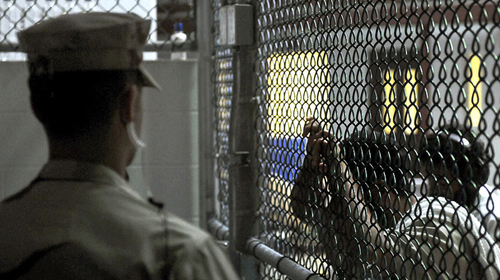
I spent much of last week at the Post Theater in Fort Meade, watching the closed-circuit feed of the pre-trial military commissions hearings in the case of Abd al-Rahim Hussayn Muhammed al-Nashiri, who faces the death penalty for his alleged role in the bombing of the U.S.S. Cole.
The CIA's torture of Mr. Nashiri, and what impact it will have on the proceeding going forward, dominated this round of hearings, both on screen and off.
"I believe Mr. al Nashiri has suffered torture, physical, psychological and sexual torture," Dr. Sondra Crosby, an expert in treating victims of torture, testified onscreen. Dr. Crosby was called by the defense to provide an opinion on whether Mr. Nashiri is receiving appropriate medical care at the Guantánamo prison for the post-traumatic stress disorder he still suffers today as a result of his time in the CIA's torture program.
Dr. Crosby's testimony provided a stark example of what it means for the government to censor testimony about CIA torture. She could say, for example, that she observed scars on Mr. Nashiri's body that are consistent with allegations of torture, but not what those allegations are. The public needs to hear the details, as terrible and uncomfortable as they may be, in open court, in order to have an informed debate about what happened in the CIA black sites and how it affects these military trials.
Off-screen, the big question was how the government would respond to military commissions Judge James Pohl's groundbreaking order, made public last Tuesday, requiring the government to turn over to Mr. Nashiri's lawyers detailed records from his "four-year odyssey" through the CIA's rendition and torture program. That would include a timeline of every black site at which he was detained; the identities of every person who had "substantial contact" with him; all of his interrogation records, as well as those of the co-conspirators listed on his charge sheet; and the government's policies and procedures related to the interrogation, treatment, and transportation of detainees it categorized as "high-value," including Mr. Nashiri.
What's so important about this information? For starters, the fact that Mr. Nashiri faces the death penalty means that his lawyers have an ethical duty to collect any facts that might persuade the military commission to apply a sentence of less than death. Here, according to his lawyers, that includes information about his brutal torture by the CIA.
Also, the government has indicated that it may use statements made by Mr. Nashiri and others after they arrived at Guantánamo in 2006. The military commission rules bar statements obtained through torture and cruel and inhuman treatment, but they don't bar subsequent statements made "voluntarily" by the defendant. There's a real question whether someone subjected to as much abuse as Mr. Nashiri could make any subsequent statement that is truly voluntary.
These issues can't be addressed until Mr. Nashiri's lawyers have all the facts about their client. Also, if information obtained from Mr. Nashiri and others after 2006 is found to be the fruit of coercive interrogations, then its use at trial is barred under the Constitution and international law.
On Wednesday afternoon, the government asked Judge Pohl to reconsider parts of his order. The judge won't make his decision until the next set of hearings, and the government has apparently indicated it will appeal if Judge Pohl refuses to rule its way.
The government has another choice, though. After all, more information about what happened to Mr. Nashiri may be released to the public soon, as the government itself acknowledged in its filing to Judge Pohl. The Senate Select Committee on Intelligence recently sent the summary of its 6,000-plus page report on the CIA's torture program to the executive for declassification review and release. That report apparently includes new facts about Mr. Nashiri, including that the CIA may have exaggerated its claims about his role in the bombing of the U.S.S. Cole.
With prospects for transparency about the torture program growing, the government could change course here, stop fighting Judge Pohl's order, and turn over all of the information it has about what happened to Mr. Nashiri to his lawyers. There can be no fair trial without it.
Learn more about Guantánamo Bay and other civil liberty issues: Sign up for breaking news alerts, follow us on Twitter, and like us on Facebook.

